
Original Link: https://www.anandtech.com/show/2674
Seasonic M12D 850W: DC-to-DC Perfection?
by Christoph Katzer on November 26, 2008 12:00 AM EST- Posted in
- Cases/Cooling/PSUs
Introduction
We visited many power supply companies during the past year, and many of them have commented, "the power supply market is dead -- there's nothing new that can be done to attract more customers." That's not entirely wrong, as PSUs are one of the components most people only think about when their old unit fails, or when building a new system. However, it's still important for power supply companies to research new technologies and features, especially if they want to stand out from the crowd. The most recent feature to make its way onto the scene is DC-to-DC technology, with several companies now sporting high-end PSUs that use it. For example, we have the previously tested Enermax Revolution 85+, Silverstone's Zeus 1200W, and Antec's Signature Series.

DC-to-DC technology is nothing revolutionary, as power supplies have always had 3.3V and 5V rails; the difference is simply that instead of taking these directly from the transformer, these rails now split off from the 12V rail -- hence, DC-to-DC. Like other companies, Seasonic has worked on implementing this technology, but they didn't want to rush the new products to market. According to Seasonic representatives, they didn't want to have end-users beta testing the technology, instead waiting until their new PSUs were truly ready for public consumption.
Today we are looking at the long anticipated M12D series, which of course features DC-to-DC technology. We want to see if there's actually difference between Seasonic's offering and the other power supplies that use this tech. Enermax already showed us that they can reach 90% efficiency with a DC-to-DC PSU, so we want to see if Seasonic can match that achievement. There's also more to building a quality power supply than raw efficiency of course, as we discussed recently, but it is worth mentioning that Seasonic has achieved 80 Plus Silver certification.
The outward appearance of the new M12D series doesn't break new ground, with Seasonic once again using their standard black design. The casing is 160 mm long, which is slightly longer than usual, but Seasonic has built PSUs for other companies that use a longer casing (i.e. PC Power & Cooling Silencer 750 Quad). Besides the DC-to-DC technology, Seasonic includes a few other interesting features, including a custom Sanyo Denki fan. The PSUs are also supposed to have very tight voltage regulation and use only Japanese manufactured capacitors. The M12D series starts at 750W and 850W, which is definitely at the high end of what most users need. We know in the past Seasonic has tended to focus on more reasonable wattages, so hopefully we will see some of the wattage models in the future.

We are testing the 850W model today, which comes with two 12V rails each rated at 40A. Again, this isn't remarkably different from other Seasonic PSUs, but it does give users plenty of juice on each rail even with sudden large peak loads. The 3.3V rail is rated at 24A and 5V rail is 30A, both of which are fine for modern systems.
Packaging and Appearance


The power supply comes in a nice package, enclosed by a bubble wrap bag. This is a modular power supply, so the extra cables come with a small bag that you can use to store the extras. You also get a manual and warranty card, which you will want to hang onto since this power supply comes with a five-year warranty.

This is another black power supply, which probably doesn't matter to most users. The power supply doesn't need to be painted at all, but somehow gray power supplies are no longer as desirable, so PSU companies have settled on black as the new standard. As always, the back is perforated to allow air to exhaust from the PSU, but there's a large Seasonic logo next to the AC jack that blocks some of the ventilation. This is nothing to worry about, however, as Seasonic placed the filtering stage right behind this area, shielded by copper plate that would have blocked airflow regardless.
Compared to some competing power supplies, the 120mm fan looks a little small -- lately we've seen 130 and 140mm fans that take up the entire bottom of the PSU. We will look at cooling and noise performance later to see if that makes a difference. The front of the PSU has six sockets for peripheral cable harnesses and two PEG harnesses. As a whole, the PSUs looks very sleek and displays great craftsmanship, which is nothing less than we would expect from Seasonic.

We took the fan grille off and power up the PSU so that you could see what's directly below the fan. We felt the fins on the heatsinks were a little too big, but Seasonic assures us the size was calculated for optimal performance. It's still better than what we've seen with CWT built models, where the fins block most of the airflow resulting in components that often get hotter than necessary. Seasonic leaves plenty of space between the wide fins, so airflow to the components below will not be a problem. Looking at the above image, you can also see that both the primary and secondary heatsinks will get plenty of airflow, so cooling should be very good.
Cables and Connectors

With the power supply of this caliber, the cables of course come with sleeving. The maximum cable length is 80cm (32"), which is long enough for most cases. However, the minimum length of 50cm (20") on the ATX connectors is only average and may not work well in full-tower cases -- particularly cases where the PSU is on the bottom. Such cases usually require cable lengths of at least 60cm if you want to route the cables nicely and keep from impeding airflow.

Most of the cables are detachable and come in an extra bag Seasonic provides. The 24-pin ATX connector, 4-pin ATX12V and 8-pin EPS12V connectors, two 60cm 6-pin PEG connectors, and SATA harness are all affixed to the power supply; all of the remaining cables are optional. The power supply provides a total of four PEG connectors, which is decent for an 850W power supply, but it's certainly possible to power higher end configurations (i.e. triple SLI -- even if NVIDIA refuses to certify "smaller" PSUs for such use).
The Fan

Sanyo Denki, a renowned Japanese fan maker, produces the 120mm San Ace fan installed in this power supply. The model number is 9S1212H403.
Internals

Opening the casing reveals a completely different design than the usual Seasonic PSUs. It reminds us of the design we saw from Acbel in the Cooler Master UCP series, as well as Impervio units from OCZ and Silverstone. There are two large heatsinks that we saw earlier, plus a smaller one on the primary side. The filtering stage is located on a small sister PCB shielded with a copper plate, at the back of the secondary side. Power then routes through a cable to the main PCB into additional filtering, and from there into the PFC stage. There are two main Nippon Chemi-Con capacitors, each rated at 390µF and 400V. These capacitors are also rated at 105°C, which is higher than most companies use.

Moving over to the secondary stage, we find additional Nippon Chemi-Con capacitors between the cables that are attached to the PCB. Below the heatsink is another sister PCB that includes the DC-to-DC circuit. We think the Enermax design was a little better here, since it also contains the cable management sockets. That allowed Enermax to clean up the main PCB, whereas the Seasonic PCB looks a little cluttered. Regardless, the end result still works well and delivers good performance.
Testing with the Chroma ATE Programmable Load

Our test equipment consists of two Chroma programmable DC Loads that enable us to test power supplies with an output of up to 1500W. The biggest advantage of the Chroma DC Loads is simply the high precision it provides. It can measure differences as small as 0.001V and 0.0001A, which will provide us with best-in-class results.
When programming the Chroma with specific amounts of load calculated according to the ATX norm, we are able to load power supplies to an exact percentage. We can now show results at every specific percentage needed. To get the best overview of a power supply, we load each unit with 10%, 20%, 50%, 80%, 100%, and 110% of the specified output. This is easy to calculate for a 1000W power supply: the 10% load is 100W and 110% load is 1100W. Remember that this is the amount of power the PSU delivers; due to inefficiencies, a power supply will actually draw more power from the wall.
Note: If you would like to know more about our testing methodology, equipment, and environment, please read our PSU testing overview.
We have added an additional 10% on the highest load to see how the units perform with overload. This test will be performed in all future reviews. The overload test is performed at room temperature as well as under more stressful conditions; to ensure we are not too cruel to the power supplies, we will keep the ambient temperature at 50°C in the stress test. Experience shows that many units can stand the overload at room temperature but will experience problems with higher temperature and overload together. Only the best-built units will survive this.

The Testing Environment
There is one flaw in testing power supplies with programmable loads while trying to measure the sound pressure levels at the same time. Because the programmable loads get very loud, there is no chance of hearing the power supply on the test stand. In order to make accurate measurements of the noise levels we needed a way to separate the test unit and the programmable loads. Our solution was to build a very thick box around the unit.
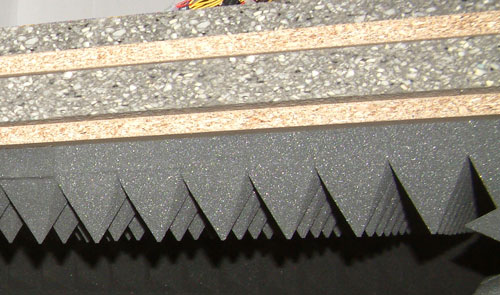
We concluded that a five-layer box with a total thickness of 6" (15cm) containing two layers of wood and three layers of special foam would suffice. It is designed as a box within a box. The inner box does not touch any part of the outer box, making it difficult for acoustic noise to pass through in the form of vibration. Each box is isolated on both sides with a layer of heavy foam that is normally used to insulate engines. On the inside we have an additional layer of 4" (10cm) thick pyramidal foam on every side of the box to eliminate the acoustic waves coming from the test object as well as we can.
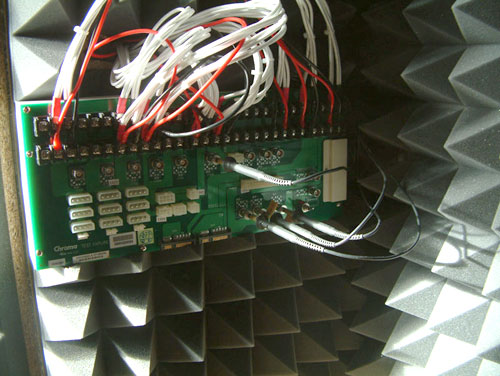
To ensure a completely closed system we installed the printed circuit board that the connectors of the power supply are attached to inside the anechoic room/box. In other box designs, you would need to put all the cables through the wall. Unfortunately, that would result in the inside of the box not being fully isolated anymore. Our design keeps everything that needs to be connected inside of the box and maintains isolation.
DC Output Stability and Quality

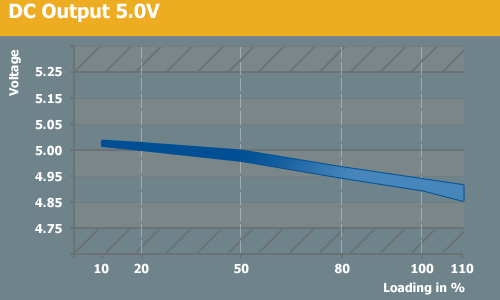
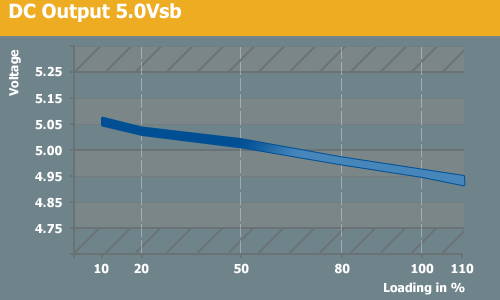
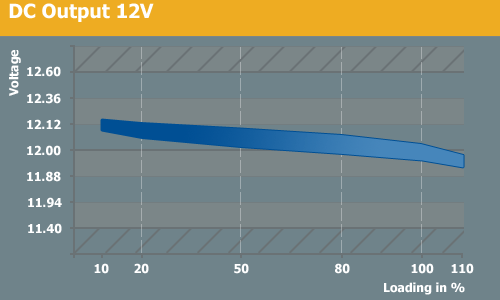
The DC output of the 12V rail was as stable as Seasonic claimed in their promotional material. Total regulation was just above 2%, which is a very good result. The lower voltage rails don't do quite as well, with regulation of up to 5%. That's still within spec, but we have certainly seen better results. Given the importance of the 12V rail, however, doing well there means more than doing well on the smaller rails.
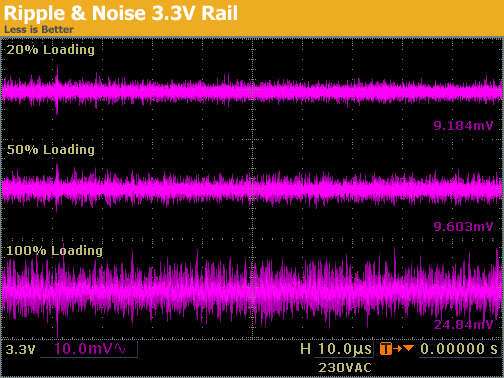
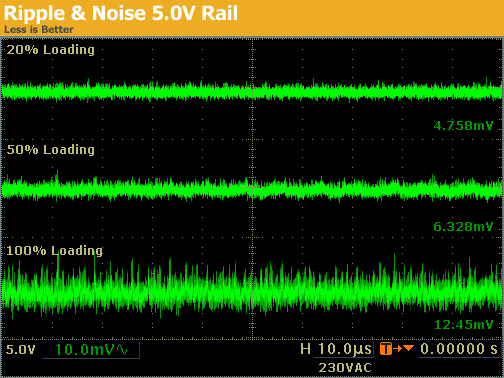
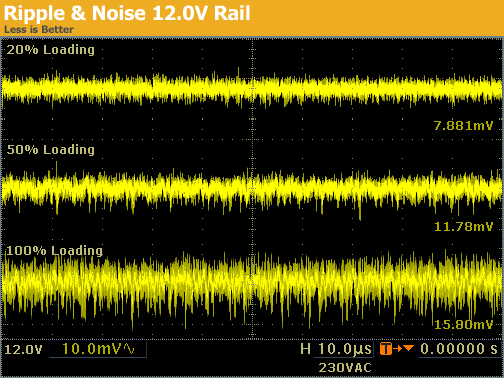
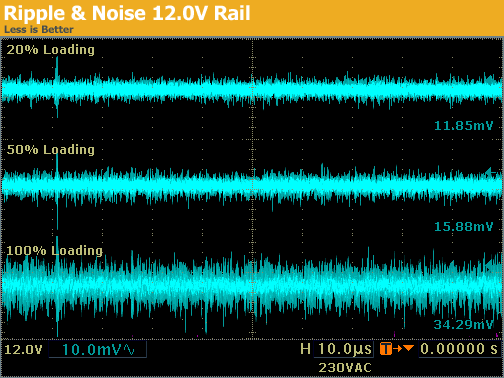
The ripple and noise measurements we measured were close to Seasonic's Chroma 8000 results. The 3.3V rail topped out at 25mV, much more than the 5V rail that stayed under 13mV. 12V1 also has very low ripple with only 16mV, but the second 12V rail tops out at up to 35mV due to a large spike.
Efficiency and PFC

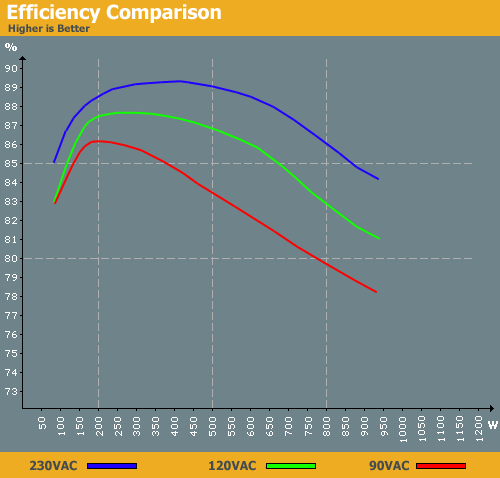
We measured up to 89% efficiency using 230VAC, which is near the top of our efficiency charts. A few power supplies have managed 90% efficiency, but as we mentioned elsewhere a difference of 1% isn't very significant. Looking at lower input voltages, efficiency is still good but the curves aren't quite as nice, with 120VAC reaching 88% efficiency, but only for a very small range of loading. After reaching the peak efficiency, the curve on 120VAC drops pretty quickly.
The M12D doesn't support 90VAC, which is listed on a sticker next to the AC input. Normally we don't have any problems testing with 90VAC, but this particular power supply definitely doesn't work properly; voltages went up and down like a roller coaster, so we used 100VAC instead of the regular 90 for the above charts. At 100VAC, the efficiency curve looks even worse, reaching a peak value of 86% at 200W and then immediately dropping. Running a load of just 200W on an 850W power supply definitely wouldn't be the best use of your money, so if you need a lower input voltage we would look elsewhere.
Getting back to where this power supply really performs well, 230VAC delivers great results. Even with just 10% load (85W) the M12D still manages 85% efficiency, which is a fantastic result. In Europe, you can run everything from 80W up to nearly 900W and still stay above 85% efficiency. 120VAC is decent as well, staying above 83% efficiency from 80W up to 800W.
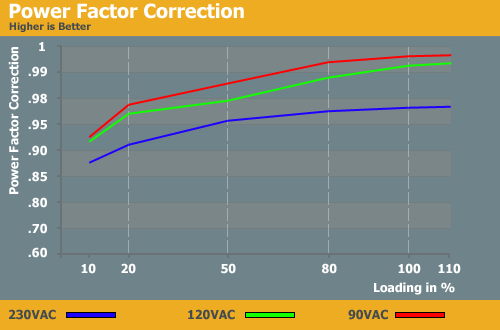
We have seen much better PFC results in other power supplies; particularly under 230VAC, this unit doesn't perform that well. It reaches a maximum of .98 -- still good, but not what most people would expect from a high-end unit. PFC with other input voltages is also lower than what we normally see.
Temperatures, Fan Speed, and Acoustics

The temperature results of the Seasonic M12D are another area where it excels, surpassing most other power supplies. When you compare the temperatures to the increasing speed of the fan, you can clearly see how well the design works. Many other power supplies ramp up fan speed even when it's not necessary, and frequently higher fan speeds and increased airflow barely manage to keep temperatures in check. In contrast, the M12D stays under 50°C at all times; there's a jump in temperature on the secondary heatsink between 20% and 50% load, but it's not enough to actually require a significant increase in fan speed. Once the fan does begin to speed up, however, we immediately see temperatures begin to fall off, showing that the heatsinks are working exceptionally well.

With loads of up to 50%, power output generally stays below 400W and this power supply is virtually silent. Only beyond 50% load is the fan begin to kick in, and as we saw above it does a good job at keeping temperatures in check, reaching a maximum 2300RPM. Seasonic is a bit conservative at higher loads, since the temperatures are still more than reasonable, but they are proud of the engineering that has gone into this design.

At maximum loads and fan speeds of 2300 RPM, it's no surprise that noise levels aren't great. Maximum acoustic noise reaches 31dB(A), which you can definitely hear -- although as usual, creating a load of 850W generally means a lot of noisy graphics card and CPU fans as well. Seasonic prefers to take a conservative approach and avoid overheating, which is good for end-users and component longevity. Given that few users will put such a heavy load on their PSU, however, noise levels of only 17dB(A) at up to 400W are practically undetectable -- it's definitely at the lower boundary of what our equipment can measure. There is however a small ticking noise that can be heard from the heavily undervolted fan, which is common with fans that used normal voltage regulation instead of a PWM controller. (Antec has the patent for PWM controllers in PSUs.)
Conclusion
It has been a while since we first heard about the M12D at CeBIT, so Seasonic has certainly taken time in preparing this product for release. Our Seasonic contact told us they found several problems with DC-to-DC modules during development and they didn't want to release their product until they were sure they had solved the problem. According to Seasonic, they build the best DC-to-DC topology available, and our results seem to support this claim with high efficiency, low ripple, and tight voltage regulation on the 12V rail. Of course, their competitors offer similar results with only minor differences, so determining who is actually best is a matter of splitting hairs.
The M12D offers everything a high-end power supply should, with a simple, sleek appearance -- you won't find any flashy LED fans here. Build quality is extremely good as usual, and they use capacitors from one of the best vendors around, Nippon Chemi-Con. We weren't entirely convinced about the heatsink design initially, but the results speak for themselves and we have to give them credit. The heatsinks do an exceptional job of cooling the components and respond quickly to increased airflow. Of course, higher fan speeds help, but Seasonic has always been conservative in that area and we don't expect them to change.
Running at up to 50% of its rated output, the M12D 850W will satisfy pretty much any user. It is extremely quiet, staying under 17dB(A), and it's also efficient and well regulated. Seasonic informed us that they don't think most users go above 50% load anyway, and they simply like to have some headroom "just in case". We would agree with that assessment, with many users running 800W and larger power supplies even if they only use a single graphics card. Whether you use one graphics card or three, you still want high efficiency and good quality, and that's what Seasonic provides with the M12D.
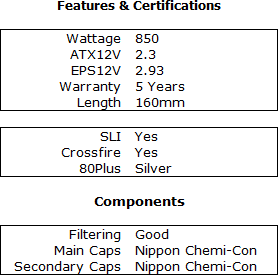 |
Depending on your input voltage, you can stay above 85% efficiency (230VAC) or 83% efficiency (120VAC) across a large range of loads. Having high efficiency at lower loads is particularly useful, since many systems sit idle most of the time. Maximum efficiency tops out at 89%/88% (230VAC/120VAC), and European users will appreciate the fact that efficiency stays at close to 89% from loads of ~250W to 550W. Voltage regulation on the 12V rails is also outstanding, staying within 1% of 12.00V throughout testing.
Looking at the competition, the Enermax Revolution 85+ needs to be mentioned -- that's the most direct competitor right now, since we're still waiting for both of these power supplies to become available. Enermax has slightly higher efficiency, but Seasonic has better voltage regulation so it's pretty much a tie. Noise levels are also similar, so it really comes down to price. The 950W Revolution 85+ has an MSRP of $319 or €249, and the M12D 850W MSRP is $299 or €199. Enermax has a slightly higher maximum output, so prices should be very comparable (with an edge to Seasonic in Europe).
The Antec Signature Series 850W is already available with a street price of $230 -- far below the MSRP of these other units. The Antec Signature has lower efficiency, higher acoustic noise, and larger voltage regulation, but it's not dramatically worse in any of these areas. Other power supplies such as the Enhance-built Zalman ZM850-HP also post similar results but only really excel in areas such as acoustic noise. One definite advantage of the Seasonic M12D over the others is that it's only 160mm long, which is crucial if you want to use this sort of power supply in a smaller mid-tower case.
Overall, it has been well worth the wait for this Seasonic unit. They put a lot of effort into making a great power supply with very good performance and high efficiency. We can't really fault the Seasonic (or any other manufacturer) too much for high acoustic noise at maximum load, since they want to minimize RMAs and few users will actually reach maximum load anyway. Focusing more on the performance and acoustics for loads of 50% or less makes sense, and for such users Seasonic delivers a great result. Anyone looking for a power supply that can deliver anywhere from 80W to 600W of output without hurting your ears will find a lot to like with the Seasonic M12D 850W.

























